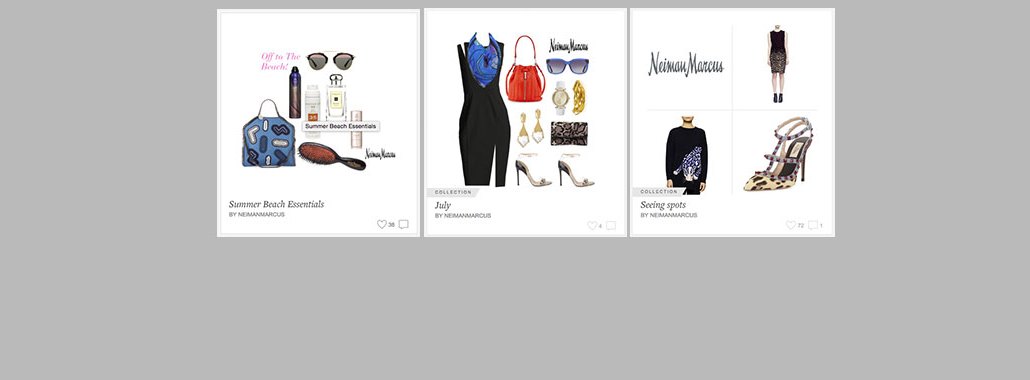How Neiman Marcus uses Polyvore for consumer insights — and to make sales

This is the second article in a series on “The Arrival of Social Commerce,” a look at how smart UI, product offerings and closing the loop on the purchase cycle can help — and who is doing it right. Read the first one, about Facebook’s shoppable pages, here.
The team at Neiman Marcus had a hunch that the color white was going to be big this summer. They didn’t know how big, exactly, until their social team checked Polyvore. It turns out users of the 8-year-old social commerce site had been posting photos of head-to-toe white outfits. So much so that Neiman doubled up on the amount of all-white clothing it promoted across its brand advertising in the summer.
Just two weeks ago, it even bought Instagram Carousel ads featuring all-white outfits from Neiman.
This level of influence is Polyvore’s point of differentiation from Pinterest, the platform it most often gets compared with. Natalie Bowman, vp of media at Neiman Marcus, said that while a lot of social partners for the company are trying to get to the part where brand building meets engagement meets commerce, Polyvore to her “represents all of it.”
 For Neiman, there’s an added benefit to being on Polyvore. Jessica Lee, Polyvore’s CEO, said that the majority of its users are style-obsessed women under 34. That’s nice for Neiman, which attracts a slightly older population but wants to appeal to the younger set.
For Neiman, there’s an added benefit to being on Polyvore. Jessica Lee, Polyvore’s CEO, said that the majority of its users are style-obsessed women under 34. That’s nice for Neiman, which attracts a slightly older population but wants to appeal to the younger set.
Neiman began its relationship with Polyvore as part of its cost-per-click model, via its affiliate programs, so people could build clothing “sets,” or ensembles, using items found at Neiman, then click through into the Neiman site to buy them.
“Later, the team was looking at select user behavior among social platforms, and Polyvore really rose to the top,” said Bowman. “It was really a place people were expressing individuality and creating style.” While Pinterest is more about wardrobes — here are some shoes someone really loves, for example — Polyvore is more about outfits. “Users create combinations we don’t expect,” said Bowman.
It’s a handy way for Neiman to fact-check what is actually trending. In the case of this summer, it was right to bet on white. In other cases, Polyvore provides the retailer with the information it needs to pivot. “We’ll have an idea in our heads as to what’s going to take off, and we can be wrong.”
The brand also is able to combine those user insights with actual commerce — a huge priority for Bowman. Neiman Marcus is one of the brands with an “official” page on Polyvore — a branded homepage with over 7,000 followers and almost 350,000 views of its sets. Other official pages are owned by retailers like Nordstrom (19,000 followers) and Sunglass Hut (616 followers).
You can follow those retailers, see sets and items and collections, and then click through to get details on outfits. Bowman declined to divulge what the return on ad spend was, but said it’s really encouraging and healthy. Engagement is high too — and the brand has seen a definite ROI on Polvyore, said Bowman.
According to the Polyvore, the average shopping basket generated by its users is worth $200 — it couldn’t break down what the number was for Neiman shoppers specifically. CEO Jessica Lee said that the company has rolled out a mobile Web cost-per-click model that’s “taken off” for Neiman, though.
Advertisers like Neiman or Sunglass Hut can place products in a “what’s trending” section on the homepage as part of a “promoted” ad unit, similar to Twitter. Polyvore is small — about 5 million monthly uniques compared with Pinterest’s 72 million. But it is more seamless: whether promoted or not, products from paid advertisers fit neatly into the site and don’t distract from the experience.
For Neiman, its fruitful relationship with Polyvore is borne out of an internal “innovation” mindset. The brand used to have a store-marketing team and an online-marketing team. Now, they all sit together, as does “social,” which used to be part of the company’s PR team. “The key part of the digital marketing team is being ROI-driven,” she said. “Social has to perform. It’s not just pretty pictures.”
More in Marketing

Lowe’s wants to do more with AI shopping in 2026
Mylow, a shopping assistant powered by ChatGPT that launched in March, is already driving double the conversion rate for online shoppers.

‘This isn’t the old pre-roll world’: YouTube has been talking TV — now it’s selling that way
YouTube is ramping up efforts to get TV’s largest advertisers to move more of their budget into its platform.

As every screen becomes shoppable, attribution problems resurface
As more media environments become points of purchase, attribution and measurement remain the thorn in the side of commerce execs.





